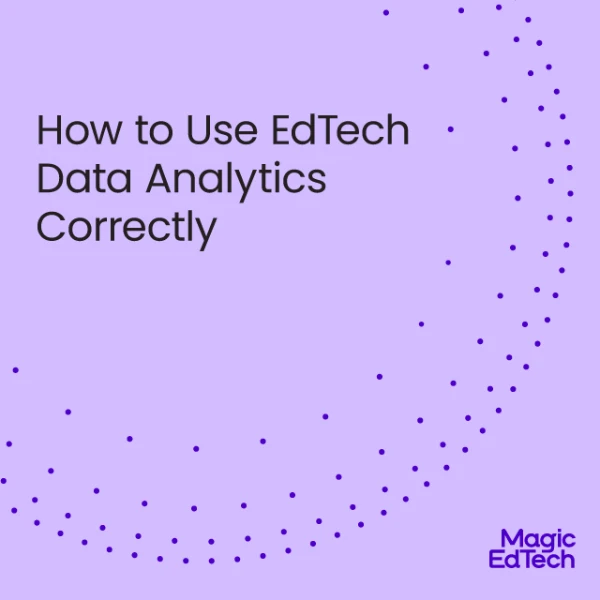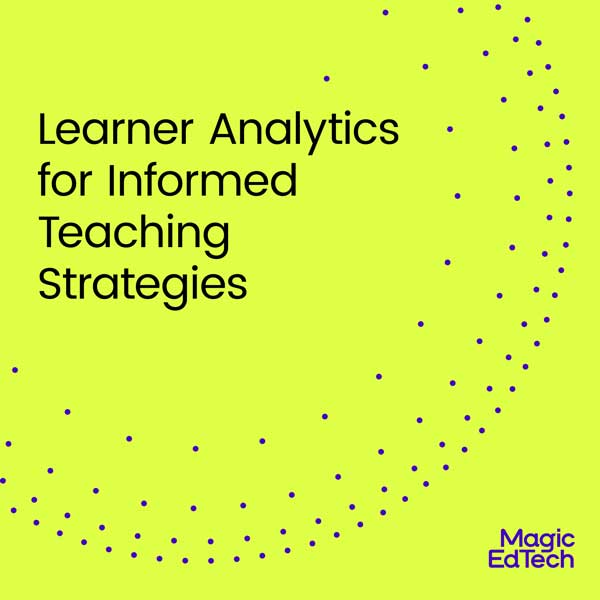Strategies for Effectively Managing Data Privacy and Security in Learning Analytics
- 3 August, 2023
- Reading Time: 7 mins
Did you know that in the last decade alone, the world has generated more data than in all of human history combined? From social media interactions to online transactions, every click, scroll, and keystroke leaves behind a digital footprint. While this data explosion presents countless opportunities, one domain that has reaped its benefits immensely is education.
It is no secret that educational technology has undergone remarkable advancements, and learning analytics has emerged as a powerful tool that has completely transformed the teaching and learning experience. Educators and institutions can make informed decisions to enhance student outcomes by leveraging data insights. However, this power comes with a serious responsibility – ensuring the privacy and security of student data.
Throughout this blog, we will explore the risks around data privacy and security in learning analytics, and reveal strategies for safeguarding student data.
Data Privacy – A Non-Negotiable Imperative
Ensuring student data privacy is not merely an option; it is an unequivocal imperative. We must be aware of the significance of data privacy in learning analytics. Data breaches and unauthorized access can lead to severe consequences, ranging from compromised student confidentiality to legal ramifications. Upholding data privacy as a core principle in every facet of learning analytics platforms is of utmost importance.
In light of the recent advancements in data protection legislation, such as the General Data Protection Regulation (GDPR), The Privacy Act, and state data protection acts like CCPA, UCPA, etc, it is paramount for educational institutions to prioritize compliance. Stringent data encryption, role-based access controls, and continuous monitoring can protect students’ sensitive information.

Key Risks in Safeguarding Student Data
Mishandling student data in learning analytics systems can lead to potential risks and severe consequences. Educational institutions and edtech providers must be aware of these risks to take proactive measures to safeguard student information. Here are some of the key risks and consequences:
- Data Breaches, Unauthorized Access, and Identity Theft: One of the most significant risks associated with inadequate data protection in learning analytics is the occurrence of data breaches, which can lead to unauthorized access to student data. If unauthorized individuals gain access, personal information such as names, addresses, and social security numbers can be exploited for criminal activities like identity theft and fraud. The consequences of such breaches extend far beyond financial loss, as they can shatter students’ trust in the institution or provider responsible for safeguarding their data.
- Academic Integrity Concerns and Inaccurate Outcomes: Learning analytics systems often collect data on student performance and behavior, making them susceptible to potential manipulation or improper use. If student data is improperly used or manipulated, it can compromise the integrity of academic assessments and evaluations, leading to inaccurate outcomes. The misinterpretation of data can misrepresent students’ abilities and negatively impact their educational journey, hindering their progress and growth.
- Data Misuse, Profiling, and Unfair Treatment: Mishandling student data can lead to the creation of profiles or labels based on student attributes, perpetuating stereotypes or biases. Misused data can influence crucial decisions, such as course placements or academic recommendations, leading to unfair treatment and unequal opportunities for certain students. Data should empower personalized learning experiences, but when improperly used, it can lead to unfair treatment for some students.
- Non-Compliance with Data Protection Laws and Reputational Damage: There can be non-compliance with data protection laws and regulations, such as GDPR or CCPA if student data is not taken care of properly. Failure to meet legal requirements may result in severe financial penalties and reputational damage to the educational institution. A tarnished reputation can lead to decreased trust from parents, students, and stakeholders, impacting enrollment and business growth.
- Limited Data-Driven Insights and Misguided Decisions: Inaccurate or mishandled data can result in flawed data insights, leading to misguided decisions in curriculum planning and support strategies. Educators and administrators rely on data to make informed choices that benefit students. However, when data is unreliable, decisions may be based on incorrect assumptions, potentially hindering student progress and the overall effectiveness of the learning programs.
- Litigation and Legal Actions: In severe cases of data mishandling, affected parties may pursue legal actions against educational institutions or edtech companies. Legal battles can be time-consuming, expensive, and damaging to an institution’s reputation. Resolving such disputes diverts resources from educational initiatives, ultimately affecting students’ learning experiences.
To mitigate these risks, educational institutions and edtech companies must implement robust data privacy and security measures. This includes encryption, access controls, regular security audits, staff training, and adherence to data protection laws. By prioritizing data privacy and security, stakeholders can ensure that learning analytics systems deliver the intended benefits without compromising student privacy and confidentiality.
Employing Proactive Data Governance Measures for a Secure Future
Knowledge and emotions must translate into action and implementing these data privacy best practices can act as catalysts for responsible data use. Therefore, regular security audits and vulnerability assessments identify and rectify potential weaknesses. A team of cybersecurity experts should diligently monitor for any suspicious activities and responds swiftly to potential threats.
By adhering to these practices, institutions can leverage the benefits of data insights to enhance educational outcomes while prioritizing student data privacy and confidentiality.
Data Security and Encryption
Implement robust data security measures, including end-to-end encryption, to safeguard student data in learning analytics platforms. This encryption ensures that data remains unreadable and protected from unauthorized access, both during transmission and storage. By employing encryption protocols, educational institutions can fortify the walls around sensitive information, mitigating the risk of data breaches and identity theft.
Role-Based Access Controls and Data Anonymization
Enforce strict role-based access controls to limit data access to authorized personnel only. By granting data access only to those individuals who require it for their specific roles, the risk of unauthorized data exposure is minimized. Additionally, data anonymization techniques should be employed whenever possible to protect student privacy. Aggregating and anonymizing data allows for data analysis while avoiding the identification of individual students. This measure ensures that educational institutions can still leverage valuable insights from learning analytics without compromising the confidentiality of student data.
Transparent Informed Consent and Privacy Awareness
Prioritize transparent communication with students, parents, and educators regarding data privacy practices. Obtain informed consent from stakeholders before collecting and using their data in learning analytics platforms. Ensure that users understand how their data will be utilized and the purpose of its collection. Educate staff members, including educators and administrators, about data privacy best practices through comprehensive training and awareness programs. This empowers all stakeholders to make informed decisions regarding their data and fosters a privacy-conscious culture within the educational institution.

Regular Security Audits and Vendor Due Diligence
Conduct regular security audits and penetration testing of the learning analytics platform to identify and address potential vulnerabilities proactively. This proactive approach will help you to stay ahead of potential threats and minimize the risk of data breaches. Additionally, if outsourcing learning analytics services to a third-party vendor, perform thorough assessments of their data security practices. Ensure that vendors adhere to relevant data protection laws and regulations, maintaining data security compliance throughout the entire ecosystem of the analytics platform.
Data Retention Policies and Incident Response Planning
Develop clear data retention policies that outline how long student data will be stored and when it will be securely disposed of. By adhering to well-defined retention periods, educational institutions minimize the potential risks associated with prolonged data storage. Furthermore, create a comprehensive incident response plan to address data breaches or security incidents effectively. This plan should outline the steps to be taken in the event of a security breach, including prompt notification of affected parties and containment measures. Being prepared with a robust incident response plan allows us to handle unforeseen data security challenges efficiently.
Privacy by Design and Continuous Improvement
Integrate privacy and data protection considerations into the design and development of the learning analytics platform from its inception. Adopt a privacy-by-design approach to ensure that data protection is embedded into every aspect of the platform. Additionally, continuously improve data privacy by staying informed about evolving protection laws and best practices. Regularly update the learning analytics platform and associated software with the latest security patches and improvements. By combining privacy-by-design principles with a commitment to continuous improvement, one can build a resilient and privacy-focused environment.
Education and Awareness Initiatives
In addition to technical measures, investing in educating staff and stakeholders about data privacy is essential to reinforce a strong data protection culture. Conducting workshops for educators and creating informative materials for parents fosters awareness and a collective sense of responsibility toward data protection. These educational initiatives ensure that stakeholders understand the significance of data privacy best practices and the potential risks associated with mishandling student.
Conclusion
Learning analytics offers incredible opportunities to transform education and improve student outcomes. However, it comes with great responsibility to prioritize data privacy and security to protect students’ sensitive information effectively. By adopting a comprehensive approach to data protection, embracing ethical principles, and fostering a culture of transparency, educational institutions can harness the full potential of learning analytics while safeguarding the trust and confidence of their students and stakeholders alike.
At Magic EdTech, we understand the significance of data privacy in learning analytics. As a leading educational technology provider, we are committed to safeguarding student data through state-of-the-art security measures and privacy-by-design principles. Contact us today to explore how our solutions can empower your institution while safeguarding student data privacy.




